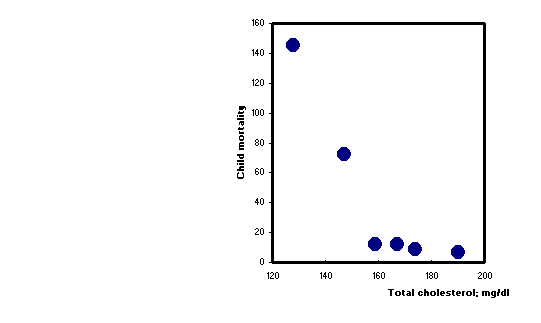|
This is a
contribution from members of THINCS,
IS
IT WISE TO SCREEN FOR HYPERCHOLESTEROLEMIA IN CHILDREN? Marshall
E. Deutsch, Sudbury, MA, USA (med41@aol.com
) and Uffe Ravnskov, Lund, Sweden Presented
as a poster at the 18th International Congress of Clinical Chemistry and
Laboratory Medicine in Kyoto, 2002. Are
High Blood Cholesterol Levels in Children a Matter of Concern? In its discussion, the AHA refers to the United States National Cholesterol Education Program (NCEP) as a source for the recommendation that attempts be made to lower blood cholesterol levels in children. The NCEP has not furnished data to justify this recommendation, but, in its initial press releases announcing this recommendation (3) presented a chart showing a fairly good correlation between the dietary saturated fat and cholesterol of boys aged 7-9 from six countries and the level of cholesterol in the boys´blood:
These data do not show any correlation of cholesterol levels with mortality or any sort of morbidity, and our repeated requesrs to the US National Center for Health Statistics (given as the source of the data in the chart) failed to elicit any indications of such correlations. We therefore referred to another source (4) which listed mortality rates for children under age 5 per 1000 live births in many countries, including the six listed above:
To
see if this relationship applies in countries other than those listed by
the NCEP, we checked the Medline database and found data for children under
20 in Mexico (145 and 149 mg cholesterol/dl for boys and girls respectively)
and children six to fifteen in Chile (146 and 154 respectively), The Britannica
mortality figures for children, as above, were 68 for Mexico and 24 for
Chile. These data conform perfectly to the illustrated relationship. Even
if High Cholesterol Were a Matter of Concern, Would Intervention Be
Justifiable? But
fatty streaks are found worldwide in almost all children, equally often in
countries where atherosclerosis is rare, as in countries where it is
frequent (5). The development of raised lesions in some individuals later in
life must therefore be due to factors other than the mere presence of fatty
streaks. Even
if fatty streaks had been the forerunners of raised lesions, the value of
cholesterol screening of children is questionable because concentrations in
childhood cannot be tracked to adulthood with any certainty. In one study,
for instance, half the hypercholesterolemic children had normal values after
12 years without any treatment (6). Even
if a screening program could identify children at high risk only, and that a
lowering of cholesterol could reduce that risk, the question remains of what
to do, because meta-analyses of all dietary trials in adults have found no
reduction of coronary or total mortality (7)
(8) (9). The
only way to lower coronary mortality is by statin treatment. There is no
evidence, however, that a possible benefit from such treatment from a young
age may balance possible side effects from life-long drug use, because such
trials have, luckily, never been performed. There
is no evidence either, that treating children with familial
hypercholesterolemia may be of benefit. In a recent study, where many family
entities with familial hypercholesterolemia were traced backwards in time,
total mortality was normal and, before year 1900 , even lower than in the
general population indicating that it is not the high cholesterol per se
that is the cause of early cardiovascular disease in some of these
individuals (10). Instead
of preventing cardiovascular disease cholesterol screening may create
families of unhappy hypochondriacs, obsessed with their diet and blood
chemistry. Besides, it may have unfortunate effects on the growth of
children because foods containing cholesterol and animal fats are rich in
important nutrients. Given all the facts and assumptions it is also doubtful
if any parents would allow their child to be screened. Literature 1. 2. 3.
Foreman J. Cholesterol curb urged for children over 2. The Boston
Globe. April 9, 1991. 4. 1992 Britannica Book of the Year. Chicago: Encyclopaedia Brittanica,
1992. 5.
Strong
JP, Eggen DA, Oalmann MC, Richards ML, Tracy RE. Pathology and epidemiology
of atherosclerosis. J Am Diet Assoc 1973; 62: 262-8. 6.
Webber
LS, Srinivasan SR, Wattigney WA, Berenson GS. Tracking
of serum lipids and lipoproteins from childhood to adulthood. The Bogalusa
Heart Study. Am J Epidemiol 1991; 133: 884-99. 7.
8. 9. 10. |
